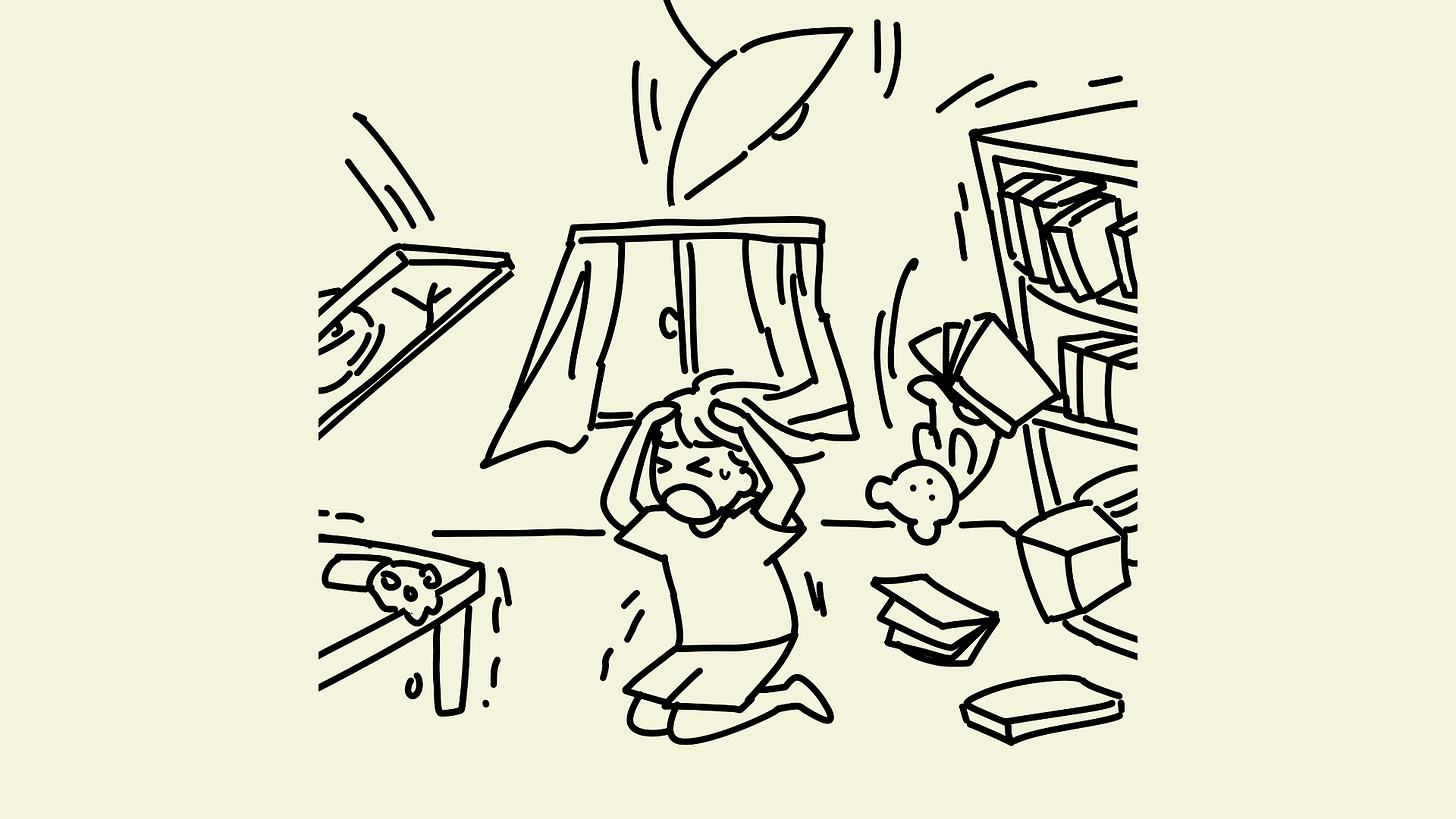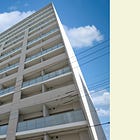Earthquake Safety: Triangle of Life vs Drop, Cover, Hold On
Explained in Easy Japanese and English

日本(にほん)についての話(はなし)ではありません。
This is not a story about Japan itself.
でも、日本(にほん)には地震(じしん)が多(おお)いので、地震(じしん)のときに命(いのち)を守(まも)る方法(ほうほう)を知(し)っておくことは大切(たいせつ)です。
But because Japan has many earthquakes, it is important to know how to protect your life during them.
ここでは、世界(せかい)で知ら(し)られているふたつの安全(あんぜん)な行動(こうどう)を紹介(しょうかい)します。
Here, I will introduce two safety actions that are known around the world.
地震(じしん)のときのふたつの安全(あんぜん)な行動(こうどう)
Two Safety Actions During an Earthquake
世界(せかい)には、地震(じしん)のときに命(いのち)を守(まも)るための方法(ほうほう)がいくつかあります。
There are several methods in the world to protect your life during an earthquake.
ここでは「三角(さんかく)スポット(Triangle of Life)」と「Drop, Cover, and Hold On(ドロップ・カバー・アンド・ホールド・オン)」のふたつを紹介(しょうかい)します。
Here, I will introduce two of them: "Triangle of Life" and "Drop, Cover, and Hold On."
1. 三角(さんかく)スポット(Triangle of Life)
Triangle of Life
三角(さんかく)スポットとは、地震(じしん)で建物(たてもの)がこわれたときや、大(おお)きな家具(かぐ)が倒(たお)れたときに、物(もの)と物(もの)の間(あいだ)にできる三角(さんかく)の形(かたち)のすき間(すきま)のことです。
The triangle spot is a triangle-shaped space between objects that appears when a building breaks or when big furniture falls during an earthquake.
たとえば、大(おお)きな家具(かぐ)や机(つくえ)、ベッドの横(よこ)にできる、つぶれにくい場所(ばしょ)です。
For example, it is a strong space next to big furniture, desks, or beds.
Triangle of Life をすすめる人(ひと)は、こう言(い)います。
People who promote the Triangle of Life say this:
「地震(じしん)で建物(たてもの)がつぶれたとき、机(つくえ)ごとつぶされた人(ひと)がたくさんいる。」
"When buildings collapsed, many people were crushed together with their desks."
だから机(つくえ)の下(した)ではなく、その横(よこ)や大(おお)きな家具(かぐ)の横(よこ)に入(はい)るほうがいいと言(い)っています。
So they say it is better to be next to a desk or big furniture, not under it.
箪笥(たんす)や大(おお)きな棚(たな)は前後(ぜんご)に倒(たお)れることが多(おお)いので、前(まえ)ではなく横(よこ)にいるほうが安全(あんぜん)なことが多(おお)いです。
Big chests and shelves often fall forward or backward, so it is often safer to be beside them, not in front.
三角(さんかく)スポットで助(たす)かった例(れい)
Examples of People Saved by Triangle Spots
ある人(ひと)は、地震(じしん)のときに紙(かみ)の束(たば)の横(よこ)にいました。紙(かみ)の束(たば)が天井(てんじょう)をささえ、すき間(すきま)ができました。
Someone survived by being next to a pile of paper. The pile held up the ceiling and created a space.
また、バーのカウンターの横(よこ)でしゃがんでいた人(ひと)も助(たす)かりました。カウンターが天井(てんじょう)の重(おも)い部分(ぶぶん)をささえ、三角(さんかく)スポットができました。
Someone in a bar also survived by crouching next to the counter. The counter held up the heavy part of the ceiling and made a triangle spot.
2. Drop, Cover, and Hold On(ドロップ・カバー・アンド・ホールド・オン)
Drop, Cover, and Hold On
これはアメリカ赤十字社(せきじゅうじしゃ)や米国地質調査所(べいこくちしつちょうさじょ)などがすすめる方法(ほうほう)です。
This is the method recommended by the American Red Cross and the United States Geological Survey.
手順(てじゅん)
Steps
Drop(ドロップ)=しゃがむ
安全(あんぜん)な場所(ばしょ)でひざをつき、しゃがみます。
Get down on your knees in a safe place.Cover(カバー)=かくれる
机(つくえ)やテーブルの下(した)に入り、頭(あたま)と首(くび)を守(まも)ります。
Get under a desk or table and protect your head and neck.
机(つくえ)がなければ、腕(うで)で頭(あたま)をかくして壁(かべ)の近(ちか)くにしゃがみます。
If no desk, cover your head with your arms and crouch near an inside wall.Hold On(ホールド・オン)=つかまる
机(つくえ)や家具(かぐ)が動(うご)かないようにつかみます。
Hold on so the desk or furniture does not move.
なぜ意見(いけん)が分(わ)かれるの?
Why Do Opinions Differ?
Triangle of Life の人(ひと)は、地震(じしん)で建物(たてもの)がこわれる場合(ばあい)だけでなく、箪笥(たんす)や本棚(ほんだな)などの大(おお)きな家具(かぐ)が倒(たお)れてくる場合(ばあい)にも、この方法(ほうほう)が有効(ゆうこう)だと言(い)っています。
People who support the Triangle of Life say this method is useful not only when a building breaks during an earthquake but also when big furniture like chests or bookshelves falls over.
でも、アメリカ赤十字社(せきじゅうじしゃ)などは「現代(げんだい)の建物(たてもの)は完全(かんぜん)につぶれることは少(すく)ない」ので、机(つくえ)の下(した)に入(はい)るほうが安全(あんぜん)だと考(かんが)えています。
But the American Red Cross and others think modern buildings rarely collapse completely, so they believe under the desk is safer.
最後に
地震(じしん)は、いつ、どこで起(お)こるかわかりません。
Earthquakes can happen anytime and anywhere.
どちらの方法(ほうほう)も、それぞれの場所(ばしょ)や建物(たてもの)の状態(じょうたい)によって向(む)いている場合(ばあい)がちがいます。
Both methods are suitable for different places and building conditions.
大切(たいせつ)なのは、ふだんから安全(あんぜん)について考(かんが)え、すぐに行動(こうどう)できるように準備(じゅんび)することです。
What is important is to think about safety in daily life and be ready to act quickly.
あなたとあなたの大切(たいせつ)な人(ひと)の命(いのち)を守(まも)るために、今(いま)できることからはじめましょう。
To protect your life and the lives of the people you care about, start with what you can do now.
Subscribe to keep reading. I appreciate your support!
This article is copyright ©. Sharing the link is welcome, but copying without permission is not allowed. Educational use is welcome.
Another easy Japanese & English article here.


